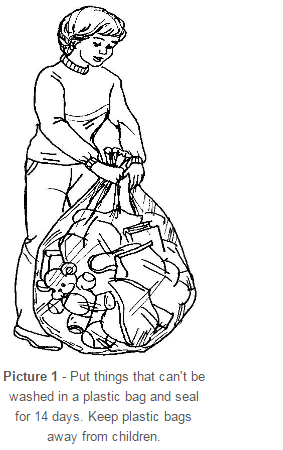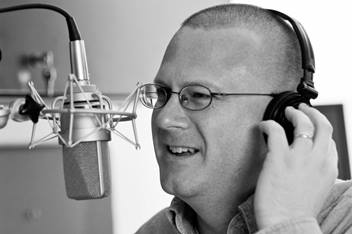Head Lice
Head lice are tiny, 6-legged insects about this long (-). They may be grayish white. If they are filled with blood, they will look red. They do not have wings, so they cannot fly. They do not jump but they can move very fast. This makes it hard to find them in the hair.
Nits are the eggs of the lice. They look like bits of dandruff in the hair but do not flake off when touched. They are stuck to the hair. They are about this size ( ' ). Nits may be yellowish white to brown.
Head lice attach their nits to a hair shaft with waterproof "glue." The eggs are laid close to the scalp where the temperature is warm and constant. It is a perfect place for them to grow and hatch. Look for nits at the back of the neck and behind the ears.
Usually the first sign of head lice is intense itching. Lice do not pass along disease. However, if the skin is scratched open, sores can get infected.
How to Get Lice
Lice are usually spread from child to child when sharing clothing, hats, scarves, combs, brushes, hair trims or helmets that have strands of hair with nits. Lice can also be passed when playing contact sports.
People of all ages and races can get lice, but they are less common in African American children. It doesn’t matter how clean you are or where you live. House pets do not carry human lice (and should not be treated).
Life Cycle of Lice
Lice spend their entire life on human heads. A louse can live up to a month if it can feed on blood several times a day. If lice fall off the scalp, they will die within a day or two.
The female louse can lay up to 8 nits per day. The eggs hatch in about a week (6 to 9 days). The baby “nymphs” need a blood meal within minutes of hatching. In another 7 days, they grow to be adults and can start laying eggs. Knowing the life cycle will help you to understand the treatment of lice.
Treatment
There are no over-the-counter or prescription treatments that totally kill both lice and nits. Nits cannot be washed out or brushed out of the hair. They must be picked or pulled out with a special nit comb or by hand.
Various natural remedies exist for treating lice but there is no scientific proof that they work.
A combination of approaches is needed:
-
Using over the counter or prescription lice medicine
-
Removing nits with a nit comb and by hand, the single most important treatment!
-
Environmental control, vacuuming and washing
-
Regular head checks followed by less frequent head checks to detect re-infestation
-
Checking others who have close contact with someone who has lice
Treatment with Lice Medicine and Removing Nits
Head lice shampoo is an insecticide. It should be used with caution. Many lice medicines are not recommended for children under 2. Check the instructions for suggested age limits.
If you are pregnant or have a weakened immune system, ask your health provider if it is safe to handle lice shampoo.
Follow these steps for most lice medicine:
-
Read the label to be sure how long the medicine should be left on the hair and how it should be washed out. Many medicines are left on for 10 minutes. Do not use more or keep it on the head longer than what is recommended.
-
Wash the hair with regular shampoo. Do not use a conditioner. It can keep the lice medicine from working.
-
Rinse well with warm water and towel dry. Do not use the towel again until it has been laundered.
-
Use a regular comb to get out any snarls. This comb will need to be treated later (see Environmental Control below).
-
Wear gloves and apply lice medicine only to the scalp. Avoid getting the medicine on other parts of the body. If it gets in the eyes, flush the eyes with water right away.
-
Stay with your child while the medicine is on the hair. Do not put a shower cap or plastic bag on your child’s head.
-
Sometimes it will be easier to remove the nits if you wet the hair with white vinegar while you are combing the nits out. Vinegar helps loosen the "glue" that holds the nits to the hair.
-
Separate and comb small sections of hair at a time. It might be helpful to use hairclips to pin up sections of hair as you check your child’s head.
-
Use a nit comb to remove the nits. Metal ones work best. Combing can take more than an hour, depending on hair length and the number of nits. You may have to pick out the nits with gloved hands if other methods do not work.
-
Place nits and lice in toilet and flush or place in a small plastic bag. Seal the bag and throw it away.
-
Wash your hands carefully. Be sure to scrub under your fingernails.
After Treating with Lice Medicine
-
Have your child put on clean clothing after every lice treatment.
-
Check for lice again in 8 to 12 hours. Use the nit comb to remove dead lice and nits.
-
If some are still present but moving slowly, do not shampoo again.
-
If lice are still active and no dead lice are found, call your health care provider. These lice may be resistant to the medicine. Do not use more than one head lice medicine at a time without asking your doctor.
-
Do not rewash hair for 1 to 2 days after the lice treatment. It may reduce the effectiveness of the lice medicine.
-
Continue to check hair and use the nit comb to remove nits and lice every 2 to 3 days for 2 to 3 weeks. This process should be done for as long as nits and lice are still found on the head.
-
Many lice medicines recommend a second treatment in 9 to 10 days. This will kill any new nymphs that have hatched since the first treatment. Do not treat a person more than 2 times with the same medicine without talking to your doctor.
-
Do not use conditioner for 10 days after any treatment.
If all nits are not removed, they may hatch into live lice. The hair will be re-infested and you will have to start the treatment process all over again.
Over-The-Counter Medicines
There are two types of medicine that you can buy without a prescription. At times, the medicine does not work. If the lice do not die after treatment, you can suspect resistance.
Nix Cream Rinse® (permethrin based product) This medicine is put on hair that has been shampooed and towel dried. After 10 minutes, the medicine is rinsed off. Nix Creme Rinse® kills lice, but not the nits. It is the favored medicine because it may continue to kill newly hatched lice for a few days after treatment. A second treatment is needed on day 9 to kill newly hatched lice. It can be used on children 2 months of age or older.
Rid®, Pronto®, R&C®, Triple X®,and A-200® (pyrethrin based product) This type of medicine is applied to dry hair and then rinsed off after 10 minutes. It kills lice and not the nits. A second treatment is needed on day 9 or 10. It cannot be used on children younger than 2 years. In addition, it should not be used by people who are allergic to chrysanthemums or ragweed. Pyrethrin based products could cause a serious allergic reaction.
Avoid using mayonnaise, olive oil, tea oils, petroleum jelly, margarine, or butter. These alternative treatments aim to suffocate the lice. They have not been proven to be effective and may be hard to wash out of the hair.
Prescription Medicine
The doctor may order a prescription lice medicine if the over the counter medicine does not work. A prescription medicine might be needed for treating lice in a very young child. These medicines have chemicals that are different than the over-the-counter medicines. | The directions for using them may be different. Some may require only one treatment. They often cost more and may not be covered by insurance.
If using the prescription medicine Ovide® (Malathion), do not use a hairdryer after treatment. Malathion has flammable ingredients that could set the hair on fire.
Environmental Control
Washable Items:
-
Machine-wash in hot, soapy water then dry. Use the hot cycle of a dryer for at least 20 minutes. Wash all washable clothing (including hats, scarves and coats) and all bed linens, towels and washcloths that have had contact with your child in the past 3 days.
-
Soak combs, brushes, hair barrettes, hair bands and sports helmets:
- In hot water (above 130?F) for 10 minutes
- In a solution made with the Nix Creme Rinse® for one hour
- In rubbing alcohol for one hour, then washed in hot, soapy water
Non-washables:
-
Vacuum all carpets and furniture, including beds. This will remove any hairs that might have nits attached that are still alive.
-
Do not spray insecticides on carpet and furniture nor hire a pest control company to treat your home. It is not necessary and could expose children to harmful chemicals.
-
Pillows, stuffed animals, clothing and other things that cannot be washed may be dry-cleaned. Or you can put them in a tightly-sealed plastic bag for 3 days (Picture 1). Any nits or lice on these things will die in 2 days.
-
Check the hair and scalp of all family members every 2 to 3 days by combing the hair until no live lice are found for 10 days. If you find nits or lice, treat that family member’s hair and clothing the same way.
It is not necessary to treat anyone unless they have lice. Treatment that is not needed increases resistance to the lice medicine.
When to Call the Doctor
-
The lice treatment has not been effective.
-
Lice remain as active as before treatment.
-
After 2 treatments, your child still has lice.
-
Your child has open, oozing sores or crusting on the scalp.
-
Your child has a fever or enlarged lymph nodes in the neck.
School and Other Parents
-
Tell parents of your child's closest friends that their children may also have lice since the children play together.
-
Tell the school nurse at your child's school. The nurse can check other children for nits and make sure they're treated too.
-
Check the lice policy at your child’s school. In some schools a child cannot return until he or she has received one treatment and is checked for live lice by the school nurse. If live lice are found, the nurse will send the child home. Although unusual, some schools may require that a child’s hair must be free of all nits before being allowed to go back to school.
Prevention
The single most important thing to prevent lice is to "Never Share What Touches the Hair." Teach your child to not share combs, brushes, hats, scarves, hair accessories, "scrunchies," helmets, headphones, or pillows.
Check your child's hair often during the school year, especially when the school tells parents there is a lice problem.
Lice: Treatment and Prevention (PDF)
HH-I-49 5/76, Revised 7/16 Copyright 1976, Nationwide Children’s Hospital



